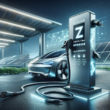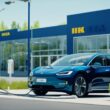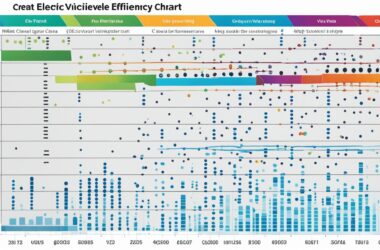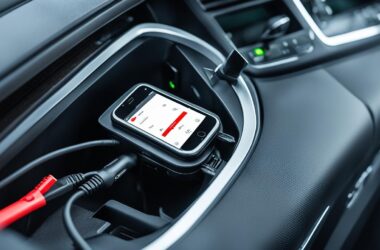Welcome to my article on V2H technology, the innovative solution that enables the transfer of energy from an electric vehicle’s battery to your home. With V2H technology, you can turn your electric vehicle into an energy storage system, contributing to a more sustainable and efficient future. In this article, we will explore the benefits of V2H technology, how it works, the challenges to its implementation, and its promising future.
V2H technology, also known as vehicle-to-home, is an exciting development in the world of smart grid technology and renewable energy integration. By utilizing electric vehicle charging infrastructure, V2H technology allows you to power your home with the energy stored in your EV’s battery. This integration not only reduces your carbon footprint but also offers various advantages in terms of energy resilience, cost savings, and grid stability.
Key Takeaways:
- V2H technology enables the transfer of energy from an EV’s battery to power your home.
- It reduces your carbon footprint and contributes to a cleaner environment.
- V2H technology provides a backup power source during blackouts.
- It helps you save on energy costs by utilizing clean energy during peak demand times.
- Implementing V2H technology faces challenges such as limited EV support and installation costs.
How Does V2H Work?
V2H technology utilizes a process called bi-directional charging to transfer energy between an electric vehicle (EV) and a home. This unique capability allows energy to be both received from and discharged to the vehicle’s battery, enabling the EV to serve as a valuable power source for the home. To understand how V2H works, let’s explore the key components and processes involved:
1. Electric Vehicle with Bi-Directional Charging
In order to harness the benefits of V2H, an electric vehicle capable of bi-directional charging is required. These EVs are equipped with technology that enables the battery to both receive and supply electricity, allowing for a seamless transfer of power between the vehicle and the home.
2. Energy Management Software
Smart energy management software plays a crucial role in controlling the V2H process. This software monitors energy levels, determines when to charge or discharge the EV battery, and optimizes the use of stored electricity based on the homeowner’s preferences and energy needs.
3. Bi-Directional Home Charger
A bi-directional home charger serves as the interface between the EV battery and the home’s electrical system. It converts the direct current (DC) power stored in the EV battery into alternating current (AC) power, which can be used to power household appliances and devices. This charger is typically installed by a licensed electrician to ensure safe and proper integration with the home’s electrical grid.
4. Communications Link and Energy Metering System
A robust communications link is established between the bi-directional home charger, the EV battery, and an EV charging management platform. This link allows for seamless data exchange, ensuring efficient coordination of charging and discharging processes. An energy metering system is also implemented to track the flow of power and accurately measure the energy consumed and stored by the EV and the home.
5. “Islanding” Process
During V2H operation, it is essential to disconnect the home from the electrical grid to ensure safety and prevent any backflow of power. This process, known as “islanding,” enables the home to operate as a standalone system, powered solely by the EV battery. The islanding process ensures a consistent power supply to the home while adhering to electrical safety standards.
By combining these elements, V2H technology unlocks the potential for electric vehicles to serve as bi-directional power sources for the home. This not only provides homeowners with backup power during outages but also offers opportunities for greater energy independence and efficiency.
Now let’s take a closer look at the benefits that V2H technology brings to homeowners in the next section.
Benefits of V2H Technology
V2H technology offers several benefits to homeowners. It provides a backup power source during blackouts, ensuring that critical appliances and devices can continue to function. Additionally, utilizing the energy stored in the EV battery can help reduce the carbon footprint and contribute to a cleaner environment. V2H can also lead to energy cost savings by using the EV battery during peak demand times when electricity prices are high. Furthermore, V2H technology contributes to grid resilience by reducing strain on the grid during periods of high demand.
| Benefits of V2H Technology | Description |
|---|---|
| Backup Power Source | V2H technology provides a reliable backup power source during blackouts, ensuring that critical appliances and devices can continue to operate. |
| Carbon Footprint Reduction | By utilizing the energy stored in the EV battery, V2H technology helps reduce reliance on traditional power sources, resulting in a lower carbon footprint and promoting a cleaner environment. |
| Energy Cost Savings | Utilizing the EV battery during peak demand times allows homeowners to save on energy costs, as electricity prices are typically higher during these periods. |
| Grid Resilience | V2H technology contributes to grid resilience by reducing strain on the grid during periods of high demand. By utilizing the EV battery for power, homeowners help alleviate the pressure on the grid, enhancing its overall resilience. |
Overall, V2H technology offers a range of benefits, including backup power, carbon footprint reduction, energy cost savings, and grid resilience. By leveraging the capabilities of electric vehicles, homeowners can not only enhance their own energy efficiency but also contribute to the larger goal of a sustainable and reliable energy ecosystem.
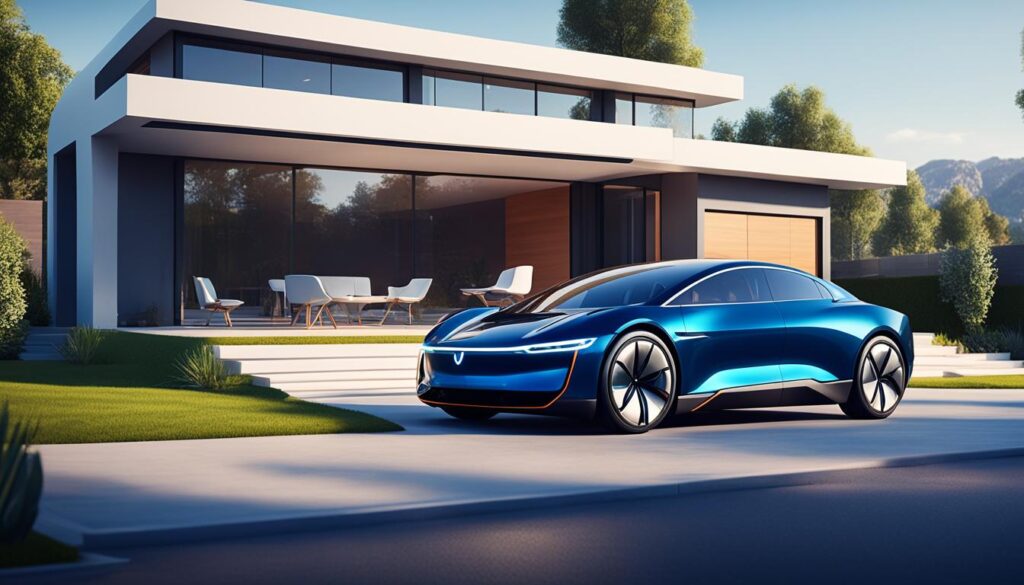
Challenges to V2H Implementation
V2H technology faces several challenges that hinder its widespread implementation. These challenges include limited EV support, installation costs, lack of uniform rules, and incentives for adoption.
1. Limited EV Support
Currently, only a few electric vehicle models offer V2H functionality. This limited number of EVs that support bidirectional charging restricts the availability of V2H technology to a smaller consumer base. As the V2H market expands, it is crucial for more EV manufacturers to incorporate this feature into their vehicles.
2. Installation Costs
The installation costs associated with V2H technology can be a significant hurdle for many homeowners. The requirement of a licensed electrician to install a bi-directional home charger adds to the overall expenses. Without affordable installation options, the adoption of V2H technology may remain limited.
3. Lack of Uniform Rules
The integration of vehicles into the grid requires consistent, uniform rules and regulations. However, at present, there is a lack of standardization in this regard. The absence of clear guidelines and frameworks for V2H implementation makes it challenging for utilities, governments, and other stakeholders to develop efficient systems and processes.
4. Incentives for Adoption
Residential and commercial customers must be incentivized to adopt V2H technology. Attracting consumers to invest in this technology requires the implementation of policies that offer financial incentives, tax credits, or other benefits. Without such incentives, the broader adoption of V2H may be hindered.
“The primary challenges facing V2H implementation are the limited number of EV models that support bidirectional charging and the associated installation costs.”
Overcoming these challenges will require collaboration among EV manufacturers, utilities, policymakers, and other stakeholders. Strategies to address limited EV support, reduce installation costs, establish uniform rules, and provide incentives for adoption need to be developed to unlock the full potential of V2H technology.
| Challenges | Solutions |
|---|---|
| Limited EV support | Collaboration with EV manufacturers to increase the number of models with V2H functionality. |
| Installation costs | Exploring cost-effective installation options and providing financial incentives or subsidies. |
| Lack of uniform rules | Developing standardized guidelines and frameworks for V2H integration into the grid. |
| Incentives for adoption | Implementing policies that offer financial incentives, tax credits, or other benefits to encourage V2H adoption. |
In spite of the challenges, overcoming these barriers can lead to a future where V2H technology plays a significant role in enhancing energy resilience, reducing carbon emissions, and optimizing energy usage in smart homes.
The Future of V2H Technology
The future of V2H technology is bright, driven by the increasing adoption of electric vehicles (EVs) and the support of regulators and policymakers. As more EV models offer bidirectional charging capabilities, the availability of V2H technology is expected to expand, providing homeowners with the opportunity to leverage their EVs as a reliable and sustainable energy source for their homes.
With the continued growth of EV adoption, there is a growing market for V2H technology. As more manufacturers scale up production, the cost of V2H components is projected to decrease, making it more affordable for consumers. This reduction in cost will contribute to the wide-scale implementation of V2H systems, benefitting both homeowners and the environment.
Regulatory support plays a crucial role in the future of V2H technology. By providing incentives and creating uniform rules and regulations, policymakers can facilitate the integration of V2H systems into residential and commercial settings. Such support will encourage widespread adoption of V2H technology and contribute to the development of a more sustainable energy ecosystem.
Increased EV Adoption and V2H Technology
The increasing adoption of EVs will drive the future of V2H technology. As more people transition to electric vehicles, the potential for utilizing their battery capacity for home energy storage becomes even more significant. The synergy between EVs and V2H technology presents an opportunity to enhance energy resilience and reduce reliance on the traditional power grid.
Cost Reduction and Affordability
As V2H technology matures and gains popularity, economies of scale will come into play, resulting in reduced production costs. This cost reduction will make V2H systems more affordable and accessible to a broader range of consumers. With improved affordability, V2H technology can reach a larger market and contribute to a more sustainable and efficient energy landscape.
Regulatory Support for V2H Implementation
Support from regulators and policymakers is essential for the successful implementation of V2H technology. A clear legislative framework and incentive programs can encourage homeowners and businesses to invest in V2H systems. By establishing uniform rules and regulations, regulators create a conducive environment for V2H technology to thrive, leading to increased adoption and widespread benefits.
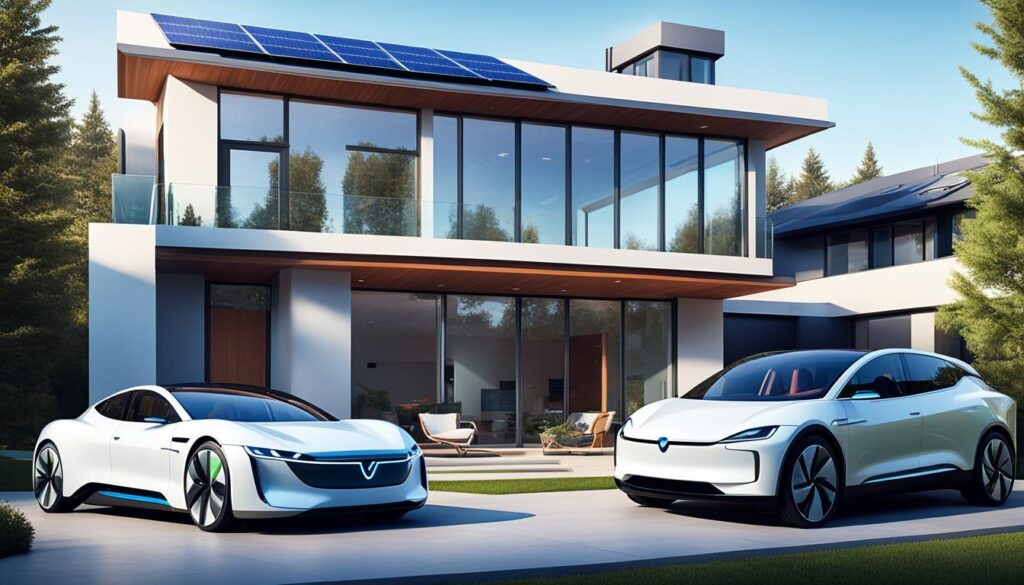
Conclusion
V2H technology is paving the way for energy resilience and smart home integration. As an EV owner, you can now harness the power stored in your vehicle’s battery to provide backup energy during blackouts. This not only offers peace of mind but also helps reduce your reliance on the grid and decrease energy costs.
By utilizing clean and cost-effective energy from your EV during peak demand times, you have the opportunity to make a positive impact on the environment while enjoying significant savings. V2H technology has the potential to revolutionize home energy storage, allowing you to seamlessly integrate your electric vehicle into your daily energy needs.
While there are challenges to overcome, such as limited EV support and initial installation costs, the future of V2H technology looks promising. With increasing EV adoption and decreasing costs, more EV models will support bidirectional charging, making V2H technology accessible to a wider audience.
Regulators and policymakers play a crucial role in facilitating the growth of V2H technology. By providing incentives and establishing uniform rules and regulations, they can empower individuals to fully embrace this innovative solution, strengthening both home energy storage capabilities and grid resilience.


